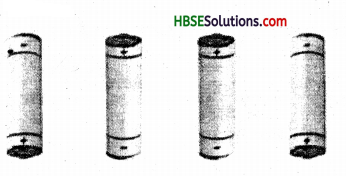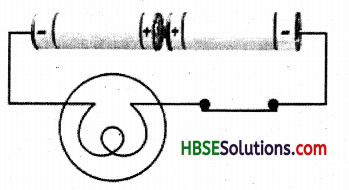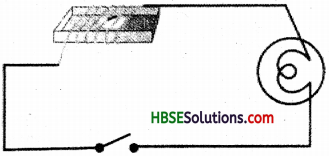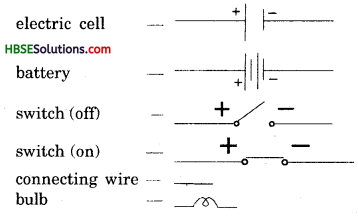Haryana State Board HBSE 7th Class Science Solutions Chapter 14 Electric Current and its Effects Textbook Exercise Questions and Answers.
Haryana Board 7th Class Science Solutions Chapter 14 Electric Current and its Effects
HBSE 7th Class Science Electric Current and its Effects Textbook Questions and Answers
Question 1.
Draw in your notebook the symbols to represent the following components of electrical circuits: Connecting wires, Switch in the ‘OFF’ position. Bulb, Cell, Switch in the ‘ON’ position, and Battery.
Answer:
Draw in your notebook the symbols to represent the following components of electrical circuits :
Connecting wires — —
Switch in off position — —
Bulb — —
Cell — —
Switch in ‘on’ position — —
Battery — —
Question 2.
Draw the circuit diagram to represent the circuit shown in Fig. 14.1.
Answer:

Question 3.
Fig 14.2 shows four cells fixed on a board. Draw lines to indicate how you will connect their terminals with wires to make a battery of four cells.
Answer:

Question 4.
The bulb in the circuit shown in Fig 14.3 does not glow. Can you identify the problem? Make necessary changes in the circuit to make the bulbs glow.
Answer:
The problem in this circuit is that of the battery. The cells have not been arranged in right series. The correct circuit is like this.

Question 5.
Name any two effects of electric current.
Answer:
Electric current has following effects:
- Electric current can give rise to heating and lighting.
- Electric current can make a straight conductor a temporary magnet.
![]()
Question 6.
When the current is switched on through a wire, a compass needle kept nearby gets deflected from its north-south position. Explain.
Answer:
When current is passed through the wire, it deflects the compass near it from its north-south position behaving like a magnet. This is called magnetic effect of the current. As we know that needle of the compass is made up of a thin magnet, when this needle comes in contact with another magnet the like poles of the magnet repell each other and opposite poles attract each other. So the deflection is seen in the needle. In this case the wire behaves like a magnet and cause deflection in needle of the compass.
Question 7.
Will the compass needle show deflection when the switch in the circuit shown by Fig. 14.4 is closed?

Answer:
No, because there is no source of electric current in this circuit i.e. there is no battery.
Question 8.
Fill in the blanks:
(a) Longer line in the symbol for a cell represents its _______ terminal.
(b) The combination of two or more cells is called a _______.
(c) When current is switched on in a room-heater, its _______.
(d) The safety device based on the heating effect of electric current is called a _______.
Answer:
(a) Positive
(b) Battery
(c) Element becomes red hot and emit heat
(d) Fuse.
![]()
Question 9.
Mark ‘T’ if the statement true and ‘F’ if it is false.
(a) To make a battery of two cells, the negative terminal of one cell is connected to the negative terminal of the other cell.
(b) When the electric current through the fuse exceeds a certain limit, the fuse wire melts and breaks.
(c) An electromagnet does not attract a piece of iron.
(d) An electric bell has an electromagnet.
Answer:
(a) F
(b) T
(c) F
(d) T
Question 10.
Do you think an electromagnet can be used for separating plastic bags from a garbage heap? Explain.
Answer:
No, the plastic bags do not get attracted by the magnet, so they cannot be separated by an electromagnet. Plastic bags are not magnetic materials, only magnetic materials like iron can be attracted by the magnet.
Question 11.
An electrician is carrying out some repairs in your house. He wants to replace a fuse by a piece of a wire. Would you agree? Give reasons for your response.
Answer:
No, we would not agree to allow to replace the fuse by a wire. Wires in the fuses are of specific metting points. So we should always use ISI marked fuses in our houses to save short circuits.
Question 12.
Zubeda made an electric circuit using a cell holder shown in Fig. 14.4, a switch and a bulb. When she put the switch in the ‘ON’ position, the bulb did not glow. Help Zubeda in identifying the possible defects in the circuit.
Answer:
It is important to put the cells in right series. The positive terminal of the cell should be connected with negative terminal of the second cell. The switch should be closed properly and bulb should not be fused. If Zubeda will check these then the bulb will certainly glow.
Question 13.
In the circuit shown in Fig. 14.5
(i) Would any of the bulb glow when the switch is in the ‘OFF’ position?
(ii) What will be the order in which the bulbs A, B and C will glow when the switch is moved to the ‘ON’ position?

Answer:
(i) No, bulb will glow.
(ii) The bulb A will glow first, follow by B bulb and then C, because A bulb comes first in the path of electric current flowing from positive terminal towards the negative terminal of the battery.
Extended Learning-Activities and Projects
Question 1.
Set up the circuit shown in Fig. 14.6 again. Move the key to ‘ON’ position and watch carefully in which direction the compass needle gets deflected. Switch ‘OFF’ the current. Now keeping rest of the circuit intact, reverse the connections at the terminal of the cell. Again switch ‘on’ the current. Note the direction in which the needle gets deflected. Think of an explanation.
Answer:
Do it yourself.
Question 2.
Make four electromagnets with 20, 40, 60 and 80 turns. Connect them one by one to a battery of 2 cells. Bring the electromagnet near a box of pins. Count the number of pins attracted by it. Compare the strengths of the electromagnets.
Answer:
Do it yourself.
HBSE 7th Class Science Electric Current and its Effects Important Questions and Answers
Very Short Answer Type Questions
Question 1.
What is electric current?
Answer:
Flow of electrons is called electric current.
Question 2.
What is conventaional current?
Answer:
The current flowing the positive end of the conducting wire towards the negative end is called conventaional current.
![]()
Question 3.
What are the different sources of current in an electric circuit?
Answer:
Cell or a battery are the sources of elctric current in an electric circuit.
Question 4.
What role does a switch plays in an electric circuit?
Answer:
The switch regulates the flow of electric current. It allows the current to pass when it is in ‘ON’ position.
Question 5.
Write the symbols of the following : Switch (open).
Switch closed and a cell.
Answer:

Question 6.
What is an open electric circuit?
Answer:
An electric circuit having the switch in ‘off position is called open electric circuit.
Question 7.
What is a closed electric circuit?
Answer:
An electric circuit having the switch in ‘on’ position is called a closed circuit or a complete circuit.
Question 8.
Which effect of the electric current enables the room heater to heat the room?
Answer:
The heating and lighting effect of the electric current enables the room heater to heat the room.
Question 9.
What is a fuse?
Answer:
It is a safety device used to avoid damages from short circuits and over loading in electric appliances.
Question 10.
Which effect of the electric current is used in Electric bells?
Answer:
The magnetic effect of the electric current is used in electric bells to make the sound.
Short Answer Type Questions
Question 1.
What is an electric current and electric circuit?
Answer:
Flow of electrons is called electric current. The path through which the electric current passes is called an electric circuit.
Question 2.
What are the components of the electric circuit? Name different components of the electric circuit and draw their symbols.
Answer:
Various elelments connected in the electric circuit are called components of the electric circuit. Following are some components of electric circuit and their symbols :

Question 3.
What is a cell and what is a battery?
Answer:
Cell and battery are both the sources of electric current in an electric circuit. A cell has two terminals – +ve terminal and – ve terminal. A combination of two or more than two cells is called a battery. Battery is formed by joining a positive terminal of a cell to the negative terminal of other cell.
![]()
Question 4.
What is an electric fuse? Explain its working.
Answer:
A fuse is a safety device used in household circuit to prevent damage to electric appliances due to overload and short circuit. It is the weakest part in the electric circuit. It melts and breaks the circuits when the problem arises in the circuit due to short circuiting, overloading or fluctuations of current in power supply system.
Question 5.
What is short circuit and overloaded circuit?
Answer:
Short circuit occurs when live wire and neutral wire come in direct contact. The short circuit occurs either due to melting of plastic insulation or connection of live wire with the earth wire. An overload circuit is the one through which more current passes than it can bear.
Question 6.
What is an M. C. B.?
Answer:
M.C.B. is miniature circuit breaker. This is a safety device like a fuse. It is used instead of or in addition to fuses, in household circuits. It is a switch that automatically switches off a current when it exceeds the specified maximum limit.
Question 7.
Write any three applications of the electromagnets.
Answer:
Fallowing are the applications of the electromagnets :
- Electromagnets are used to separate scrap iron from other metallic scraps.
- Used in electric motors of washing machines, fans, air conditioners etc.
- Used for preparing strong magnets.
Long Answer Type Questions
Question 1.
Explain the construction and working of an electric bell with help of a labelled diagram.
Answer:
An electric bell consists of an electromagnet, Armature, contact spring, Hammer and gong.
Electromagnet: It consists of a U-shaped soft iron rod having insulated copper wire wounded on it. One end of wire is connected to terminal T and other to the brass stud.
Armature: is a soft iron rod, suspended to brass stud. It faces the poles of the electromagnet.
Contact spring is attached to the armature and to a silver-cadmium alloy contact point. Spring is made up of steel.
Contact screw adjustment: It is a brass pillar having a brass screw passing through it. The tip of the screw is made up of silver cadmium alloy. Pillar is connected to T2 with a copper wire.
Hammer and Gong : Hammer is made up of steel and is attached to the armature. Gong is made up of brass, and the hammer strikes the gong to make the sound.
Working : When electric current passes through T1 and T2, current passes from the battery to electromagnet, then to the contact screw and to T2 completing the circuit. Electromagnet pulls the armature towards itself, the contact spring gets under tension, hammer strikes against gong thus making the sound. The whole process stops, when current stops flowing.

Electric Current and its Effects Class 7 HBSE Notes
- Flow of electrons is called electric current.
- The path in which the electric current flows is called an electric circuit.
- Conventially the current is said to flow from positive end of the conducting wire to the negative end of the conducting wire.
- There are many components which are attached to the path of the electric current. These are called the elements of the electric circuit,
- Elements like cell, battery, switch, bulb, connecting wires are represented by different symbols.
- Cell and battery are the sources of the electric current in a circuit. Battery is the combination of two or more than two cells.
- A circuit is said to be complete or closed when the switch regulating the flow of the current is in ‘on’ position when the switch is in ‘off’ position the circuit is called open.
- Flow of the electric current causes certain effects like heating and lighting and electromagnetism.
- The electric appliances like room heaters, gysers, rods etc. give out heat due to heating effect.
- When electric current passes through a magnetic substance like iron, it behaves like a temporary magnet.
- Electric bell works on this principle.
- Hans Christian Oersted found out the relation between electricity and magnetism.
- A fuse is a safety device used in the household circuits to prevent damage to electric appliances due to overload or short circuits.